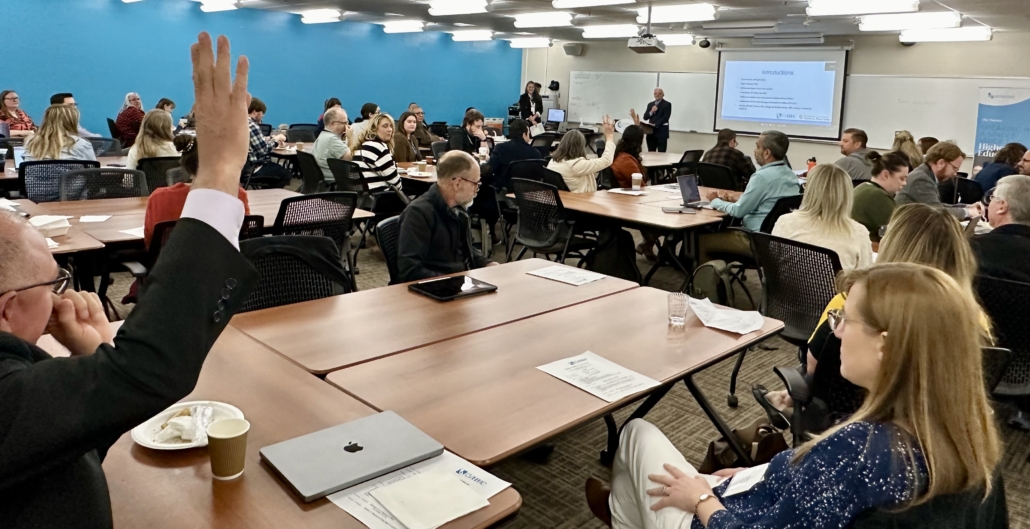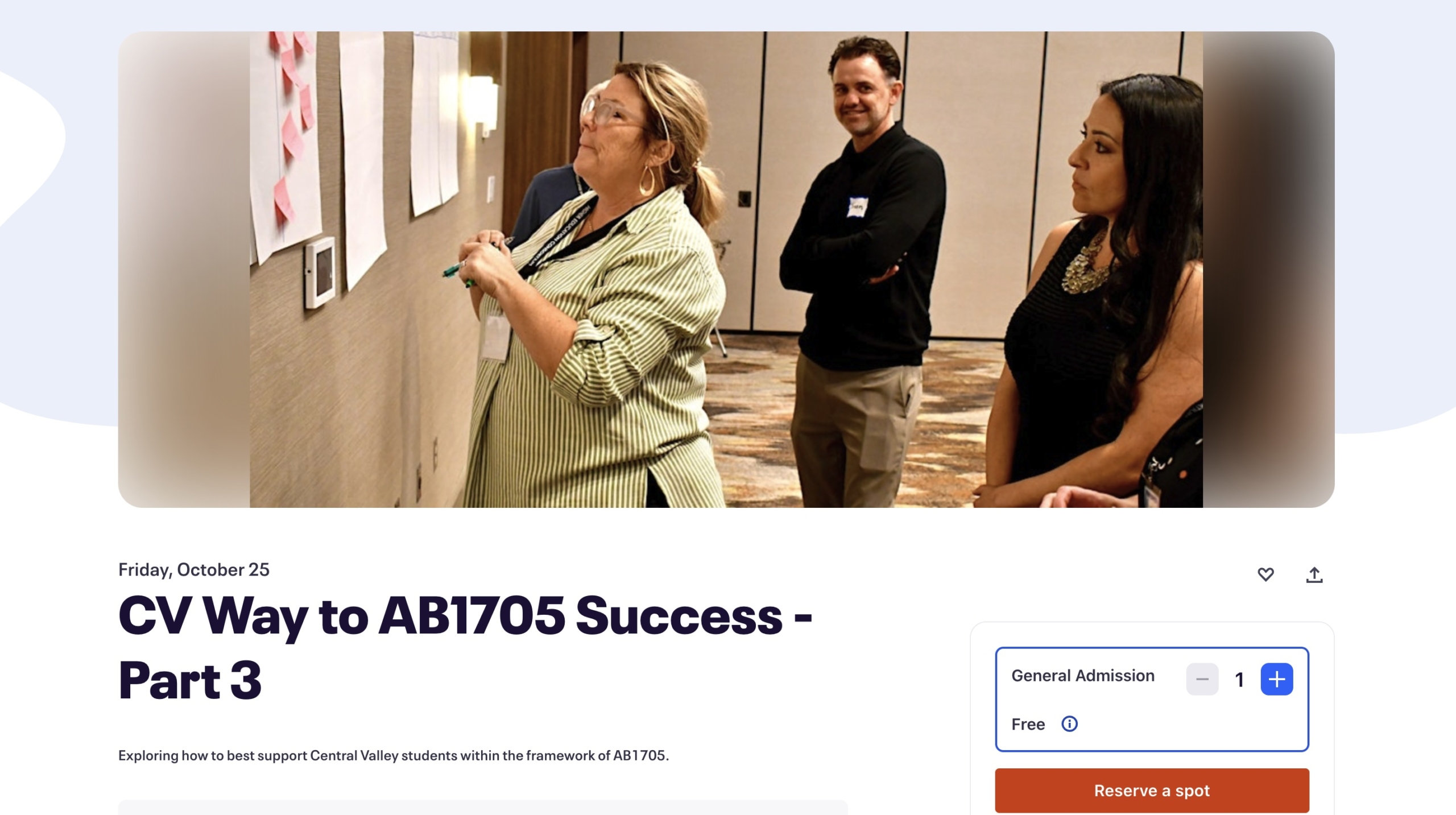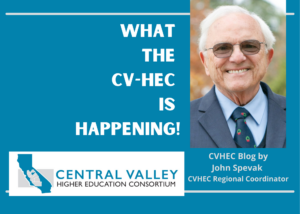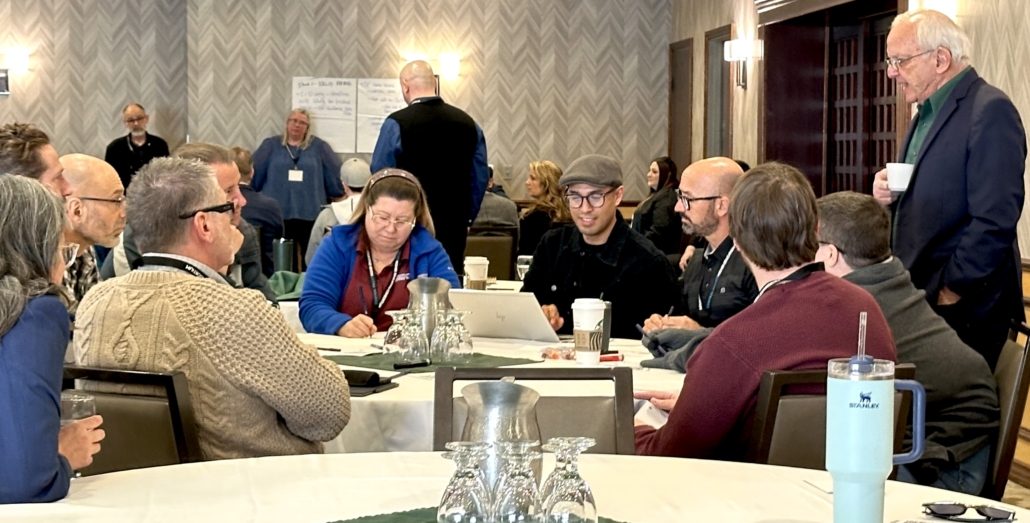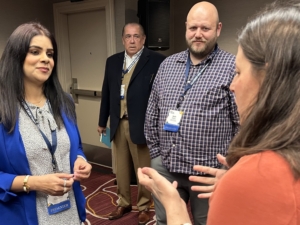 In the “What the CV-HEC is Happening” Blog for our September 2025, Dr. John Spevak presents an adaptation of a column he wrote for the August 6 issue of The Westside Express touting the effectiveness of higher education, its impact on students and the return on investment (ROI). Dr. Spevak, who is a vice president-emeritus of Merced College and currently a CVHEC lead, coordinates the English and Math Task Forces for the consortium. We welcome feedback as well as ideas for future blog topics: cvheccommunications@mail.fresnostate.edu.
In the “What the CV-HEC is Happening” Blog for our September 2025, Dr. John Spevak presents an adaptation of a column he wrote for the August 6 issue of The Westside Express touting the effectiveness of higher education, its impact on students and the return on investment (ROI). Dr. Spevak, who is a vice president-emeritus of Merced College and currently a CVHEC lead, coordinates the English and Math Task Forces for the consortium. We welcome feedback as well as ideas for future blog topics: cvheccommunications@mail.fresnostate.edu.
Please, no war on college education
… and check out your local community college for true return-on-investment
BY DR. JOHN SPEVAK
CVHEC Math & English Task Force Lead
Vice President-Emeritus – Merced College
It seems these days that there is a war on education, especially on college education.
One national commentator wrote that college is an “overpriced scam.” Another stated that “many college degrees are useless.” I could cite dozens more, but I think most of my readers have heard some pundit say or write something similar.
These commentators believe that college isn’t worthwhile and that it’s too expensive. That may be true in some cases, but community colleges in California, like the college campuses on the Westside of the Central Valley in Los Banos and Firebaugh, prove these statements wrong.
Besides these two campuses, I have visited almost all of the other community colleges in California. They are friendly and welcoming to all students and accept 100% of all students who apply.
I have a long history with the Merced College campus in Los Banos. Over the past 50 years, I have heard hundreds and hundreds of students who attended that campus tell me the education they received there improved their lives significantly without hurting them financially.
I personally know many of these people. They have improved the quality of life in this community. Los Banos Campus alumni and alumnae are successful businesspersons, farmers, teachers, nurses, radiologists, sonographers and on and on. The same could be said for every California city which includes a community college campus.
People who claim that young people should not bother going to college always have a narrow definition of what a college is. College is not limited to four-year universities and abstract majors. “College” also includes community colleges, with programs that include education in what over the years has been called “vocational education,” “the trades” and “career technical education.”
The career tech programs on the Westside of the Central Valley include welding, agriculture, computer technology and emergency medical technician (EMT).
The main campuses of their colleges, in Merced and Coalinga, offer even more, including licensed vocational and registered nursing, mechanized agriculture and automotive technology. I would bet the complete list of career tech programs in California community colleges would list more than 100 vocational programs.
All of these programs provide the education and training that enables a person to earn a decent salary on a path to earn enough money for individuals to support themselves and their families. Any employer who has hired these students will tell you that their community college education was an important factor in hiring them.
But wait! There’s more! California community colleges, like the campuses in Los Banos and Firebaugh, also offer a wide variety of transfer programs that enable students to complete their first two years toward a four-year degree and then transfer to a university at very little or no cost.
These transfer students enter the universities as juniors and are well on their way to bachelor’s degrees in the sciences, business, advanced computer technology, and other fields that will enable them to earn a very significant income.
What I find ironic about people who say a college education isn’t worthwhile is that they themselves have a college education and they want their children to have a college education. These people feel, however, that OTHER parents’ children don’t need it.
They want their own children to have a college education because they know the facts. Studies show that a college education, two-year or four-year – significantly increases the earning capacity of graduates.
Over their entire working life, according to the Hamilton Project, the typical high school graduate will earn $580,000, the typical associate’s degree graduate will earn $855,000, and the typical bachelor’s degree graduate will earn $1.19 million in today’s dollars.
The key word in these statistics is “typical.” There are some cases of students with just a high school diploma earning more than a college graduate, but they are not typical. Another way of putting it is “What are the odds of earning a good income?” Smart parents, including those who declaim against a college education, know that the odds are with students with degrees.
When I talk with young people wondering if college is worth it, I suggest they go to something called “Program Pathways Mapper.” It’s an online site that’s free to all and doesn’t require a password. One way to get to the Mapper is to Google “Merced College Program Pathways Mapper.”
Once on the Mapper site, they can select one of the many career fields, like “Agriculture and Industrial Technology,” and scroll down to “Career Explorer.” There they can see the jobs available in that field, the average salary of that job and the education required, whether bachelor’s degree, associate’s degree, or high school diploma. For many it’s an eye-opening experience.
I also tell young people that a college education is no guarantee of a high-paying job. They need to have initiative and a work ethic and a willingness to adjust to the working world and its demands, as well.
My parents didn’t have a college education. In fact, they didn’t have a high school diploma. But they encouraged their children to get a college education, and for that I will be ever grateful.
I, in turn, encouraged my three children to get a college education, and they all did, including attending the Los Banos Campus of Merced College. That, and a strong work ethic, enabled them to go into careers that paid a good salary and enabled them eventually to own their own homes—all without significant student loan debt.
For anyone who has doubts about what I have written, I encourage you to look at a recent study done by College Futures Foundation (CCF): “Golden Returns: A Regional Look at the Return on Investment (ROI) of California’s Community and Career Colleges.”
As the CCF website puts it, “This new analysis ranks 327 community colleges and certificate-granting institutions—including 121 public, 186 for-profit, and 20 private non-profit—located within the state across 12 of California’s economic regions by how long it takes learners to recoup their educational costs.”
As the brief summary on the website states: “Forty percent of public two-year colleges enable students to recoup their costs in under a year, compared to just 5% of private non-profit and for-profit institutions.”
Anyone can go to the website, find their closest community college, and see how quickly students there recover their costs. Seeing the positive ROI is another way of pointing out to people who argue against a “college education” that they are way off base.
So before you believe anyone who tells you that a college education isn’t worth it, explore the issue on your own. And if you end up agreeing with me, encourage young people you know to attend their local public community college campuses.
There’s no better time to start than now.
John Spevak’s email is john.spevak@gmail.com.

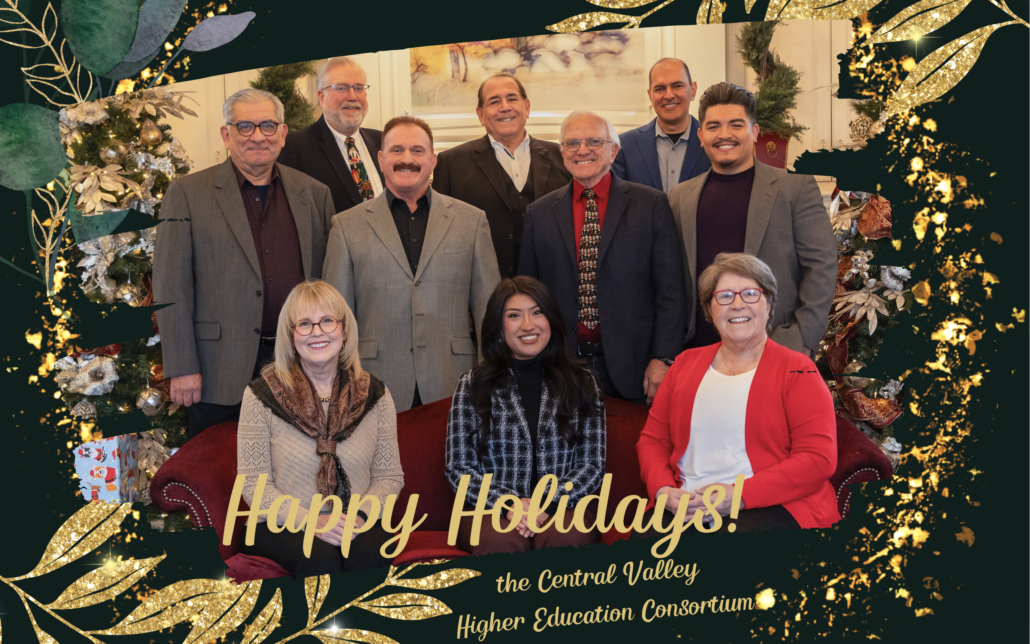
 Among the many successes of this past year is the historic mission to address implementation of Assembly Bill 1705 with our Math Task Force convening community college math education professionals from throughout our 10-county region to communicate and collaborate for strategies that benefit valley college students. We have also seen great advancement of our Transfer Project which completes its first year as a California Community Colleges Demonstration Project.
Among the many successes of this past year is the historic mission to address implementation of Assembly Bill 1705 with our Math Task Force convening community college math education professionals from throughout our 10-county region to communicate and collaborate for strategies that benefit valley college students. We have also seen great advancement of our Transfer Project which completes its first year as a California Community Colleges Demonstration Project.